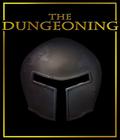While the concepts of permadeath and procedurally generated levels aren't new to the world of video games, they've certainly become more popular over the last decade. Even without those concepts, it's hard to deny that players crave a tougher gaming experience, which has been proven with the success of From Software's Souls series. While big-name publishers and AAA studios have certainly picked up on the resurging popularity of these concepts, independent developers are at the forefront when it comes to implementing what many would refer to as "old-school" mechanics.
The Dungeoning, an indie title developed by Nick Donnelly, does a pretty good job of showcasing what makes these titles so fun. On the surface, it's a very simple game with small sprites, straightforward enemy and level designs, and very basic combat mechanics. It's incredibly replayable, though. It features permanent death, no saved progress, and bite-sized levels that can be overcome if you're patient enough to look out for danger. You'll play for a maximum of 20 minutes before hitting the "game over" screen, but these bite-sized chunks of gameplay make it easy enough to pick up and play at any time. The thought of getting just a bit further than before makes it a tough game to put down.
Each play session features randomized levels that get progressively tougher. One stage features a variety of paths, but to exit the stage and advance to the next, you'll need to find the exit. The door needs to be unlocked, so once you've exhausted the initial two keys granted at the start, you'll also need to hunt down the door key for each stage. Every stage features a number of enemies to defeat, and upon doing so, you're granted a small amount of experience. Gain enough experience, and you can level up by distributing one point toward Defense, Magic, Strength or Vitality. Each stat can be enhanced up to 30 points, and you'll start the game with five points in each stat.
Enemies consist of a variety of basic role-playing game foes, like bats, ghosts, rats, slimes and more. As you progress through the levels, you may encounter tougher versions of existing foes. For example, you'll start against green slimes that move along the floor as they intermittently discharge blobs of goo in two different directions. Later, you'll encounter red slimes that hang from the ceiling, drop down when you get close and adopt the attack pattern of their green brethren. I occasionally encountered rare enemies, like a green mass filled with eyes that hunted me down across a limited patrol route. Enemies also vary in strength, durability, and aggressiveness. Rats and slimes generally ignore you, while ghosts and bats chase you down.
Each randomly generated stage also features a number of hazards to avoid. Destructible thorn bushes can yield berries to restore health and mana. Spikes are pretty prevalent throughout, and exploding barrels can cause quite a bit of damage if you get too close when attacking. You also deal with tough-to-spot falling blocks, typically hidden in the ceiling and masked by adopting the tile design around it. In later stages, you encounter pneumonic presses, and falling from a great height can knock down your HP quite a bit.
There are a number of secrets to uncover and vendors to visit. Secrets can be hidden behind passable walls, often identifiable if you know what to look for. There are breakable walls to uncover, so it's worth your while to occasionally smack bricks with your sword. While your goal for each stage is to find the exit, it's worth the time and effort to explore, since some stages have vendors tucked away. These sellers often offer better weapons, including enhanced bows, slingshots and swords, along with ammo and healing items. While weapons and consumables can drop from breakable objects in stages, they are few and far between, so vendors provide a reliable source of goods in The Dungeoning.
As mentioned previously, the combat in The Dungeoning is simple but works well within the mechanics of the game. It's an area where you can also see a heavy Demon's Souls/Dark Souls influence, despite the 2-D playing area. You have the ability to swap between three weapons, starting off with a basic sword, bow and slingshot. The sword has just enough length so you're not forced too close to enemies. Foes also tend to stagger when hit, so that pushes them back to give you some breathing room. While the bow and slingshot are both obviously ranged weapons, their projectiles have different arcs, with the arrow tending to go further than the stones from the slingshot. You also have a shield and can block at the expense of speed. I rarely found a use for it, though.
As far as mobility goes, you can jump pretty high, and movement feels akin to Super Meat Boy but without the breakneck speed. You can also wall-jump once before needing to land, and ladders are liberally available throughout stages to provide access to higher platforms. There is fall damage to look out for, but only when performing jumps that far exceed your standard jump heights. You can also jump backward from a standing position, a helpful move that feels similar to a dodge function in a 3-D title; it's useful for getting you out of dangerous situations.
Visually, The Dungeoning takes a simple approach to sprite-based 2-D graphics. Your character and the enemies are pretty small, and a lot of repeated tile designs comprise the ceilings, floor and walls of stages. There are some filler background items that add some ambience to the dungeon setting, and some small graphical effects like the Dark Souls-inspired energy that flows out of dead enemies to represent gained experience. I really like the look of The Dungeoning, despite the fact that it's not the most impressive visual experience. It still has a very distinct design that stands out from other, similar titles like Rogue Legacy. While the sprites are small and the levels look repetitive, there's a certain level of charm to the game that's hard to quantify but equally difficult to deny.
My issues with The Dungeoning are few and far between, but none are about the actual gameplay. My chief complaint is pretty minor: the lack of in-game options available from the start screen. When launching the game from Steam, it's automatically in windowed mode, and since I do a lot of my PC gaming on a TV screen, I prefer to play games in full-screen mode. You can do that with The Dungeoning, but you're required to start a new game before you can access video/audio options. It's a strange decision that may just be an oversight, but I found it to be a little annoying. Also, when blown up to the full screen, there doesn't seem to be an option for 16:9 screen sizes, so I always saw black bars on the left and right of the screen. I wished that I could keep item descriptions toggled on, as opposed to pressing an analog stick when viewing them. Again, these are all minor nitpicks, but the functionality would've been nice.
Considering how difficult the game can be, The Dungeoning might not be for everyone, but it's still worth checking out. It doesn't have all the bells and whistles of other, higher-priced titles in the genre, but it clearly understands what makes the core mechanics of a "roguelike" work. The Dungeoning is also supremely replayable, with some randomization behind its procedurally generated stages, which will take ages to tire of, provided you find the core concept fun. A demo is available for download, and it provides a good indication of what the full game offers.
Score: 8.5/10
More articles about The Dungeoning










 In The Dungeoning, players explore an ever-shifting castle as they fight through the depths to obtain a sacred artifact.
In The Dungeoning, players explore an ever-shifting castle as they fight through the depths to obtain a sacred artifact.










